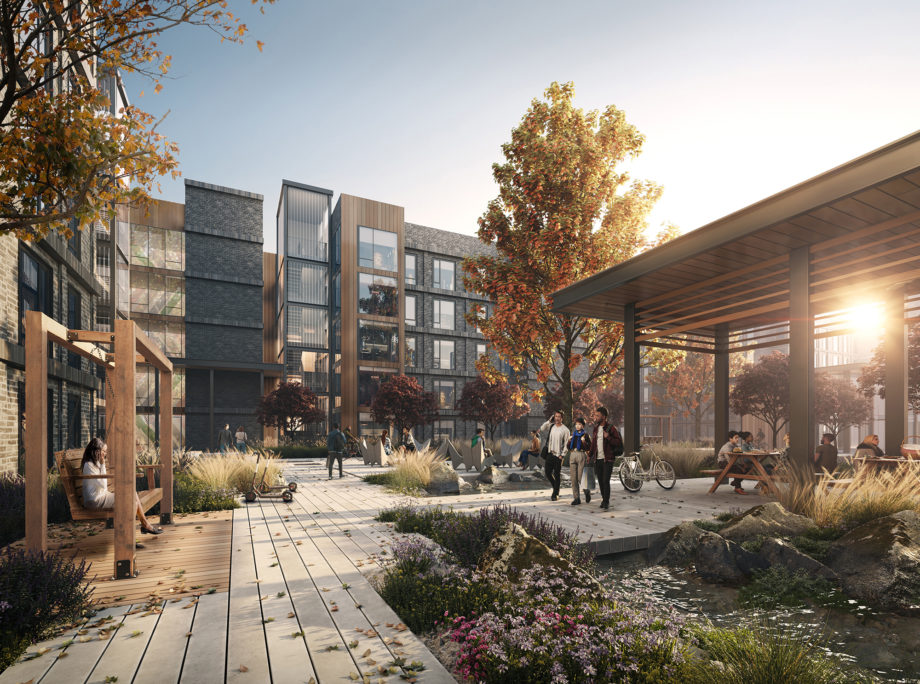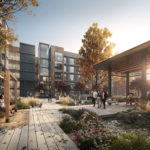Thrive Hall
November 14, 2022
A Student Housing Concept for Mental Health and Wellness
TYSONS, Virginia– KTGY, the full-service architecture, branding, interior and planning firm, has an extensive track record in designing student housing. Based on its experience creating over 14,000 student housing beds, KTGY is continually refining all parts of the student housing equation – including the acute need for these environments to foster mental and physical well-being.
The following summarizes the firm’s research and recommendations for this very specific type of development.
Young adults heading off to college often experience a rude awakening when living on their own for the first time. The dramatic transition toward increased independence and autonomy thrusts young people into a new reality, far from the stability of their parents’ oversight and guidance. Former university psychologist Dr. Beth Staehling Becerra noted that teens transitioning to the independence of college life often struggle with even common disappointments. A breakup or poor grade may become overwhelming without additional social or professional support.
The World Health Organization recognizes that physical, emotional and social changes can leave adolescents vulnerable to mental health issues, leading to higher instances of social exclusion, discrimination, stigma, educational difficulties, risk-taking behaviors, physical ill-health and human rights violations. A Center for Disease Control and Prevention report published in 2022 found a rising number of teens and young adults are experiencing depression and feelings of hopelessness. And a study conducted by the Center for College Mental Health at Penn State University surveyed 160 college and university counseling centers and found instances of suicidal ideation among college students rose from 13 percent in 2010 to 37 percent in 2019.
“Some universities and student housing developers have noticed this alarming trend and are creating programs to address them,” said KTGY Director, Design, Marissa Kasdan. “However, typical building designs often do not adequately accommodate the types of spaces necessary for implementing such programming. And challenges brought on by new roommate relationships and insufficient support for healthy lifestyle choices can exacerbate mental health issues.”
Meanwhile, housing costs have increased dramatically throughout the United States. According to the National Center for Education Statistics, from 1990 to 2020, the average room rate for student housing within a four-year institution increased 111 percent, adjusted for inflation. As student housing developers consider reducing construction costs, they may be sacrificing the student wellness.
However, some developers and operators have taken bold steps toward supporting these mental health challenges. For example, American Campus Communities created the “Hi, How Are You Project,” a college student mental wellness advocacy coalition. Their program includes outreach opportunities and resources specifically to support students and remove the stigma around mental health. KTGY looks for opportunities to further these efforts.
Among the more than 14,000 student housing beds designed by KTGY, all include unique parameters; however, many design commonalities arise: Units are typically organized in apartment-style configurations, allowing students to eat, sleep and study without leaving their unit; amenity spaces are generally large and concentrated in a few locations; and corridors are often long and fully enclosed. By challenging these design assumptions, KTGY’s research and development concept, Thrive Hall, proposes a new strategy for prioritizing the mental health and wellness
Designs that encourage students to interact with one another and the spaces around them mitigates isolation, anonymity and lack of self-care. The Thrive Hall design concept focusses on seven distinct design objectives:
The Thrive Hall concept reconfigures the typical student housing model to encourage social connectedness, promote healthy habits and increase exposure to the outdoors and natural light.
Creating Community
Research by the British evolutionary anthropologist Robin Dunbar shows that groups beyond 150 individuals lead to an inability for group members to “function effectively in social relationships.” Ideally, groups of 50 or fewer friends, including 15 good friends and five intimate friends, support healthy relationships. By creating pods of rooms and shared spaces intended to house 30 individuals, student housing can support the formation of strong friendships and connections.
Reinforcing Community
Using the principles enlisted for modern co-housing, the Thrive Hall concept minimizes the bedroom and unit area and creates shared living, dining, kitchen and study areas for use by the residents within a 30-student pod. A 2017 study by Oxford University found that people who frequently eat with others are more likely to feel happy and satisfied with their lives.
Sleeping Nooks for Quality Rest
A 2021 report by the CDC outlined the strong correlation between sleep and mental health. Within the study, those who averaged less than six hours of sleep per night were about 2.5 times more likely to experience mental health issues than those averaging more than six hours per night. In student housing situations, incompatible roommate habits may hinder the length and quality of rest, leading to both physical and mental health issues. One solution is sleeping nooks with sliding privacy doors. These create a visual and acoustic separation for students sharing a sleeping space.
Intentional Study Spaces
As the brain creates associations between different experiences, the stress and stimulation linked to studying negatively affect the brain’s ability to rest. Therefore, removing desks from the sleeping rooms and relocating them to shared spaces within the students’ pods creates distance between spaces for productivity and spaces for relaxation, increasing the effectiveness of both. Additionally, with shared study spaces, a diversity of seating configurations creates flexibility for various study needs. For example, lounge seating replicates coffee shop studying, and enclosed study rooms cater to group studying.
Connection to Nature
Access to nature can improve both physical and mental health. Improved sleep, reduced stress, increased happiness and reduced negative emotions are a few of the benefits linked to natural environments. Additionally, correlations have been made between green environments and an increase in attention, memory and creativity. Ongoing exposure to daylight boosts serotonin and natural circadian rhythms leading to improved sleep quality.
Encouraging an Active Lifestyle
A strong correlation connects physical health with mental well-being. For example, encouraging students to be active by taking the stairs or using the on-site fitness facilities can mitigate long-term physical health issues. Likewise, serotonin levels increased by regular physical activity improves digestion, sleep, mood and physical healing.
Mental Health Support
Even as mental health challenges become more than they can handle alone, students may feel intimidated to reach out for the help they need. Student housing developments can repurpose leasing spaces during the off-season to provide counseling rooms for classes and seminars. By incorporating mental health support within the student housing development, students become familiar with the help available to them and the barriers to access are reduced. Multiple entry points and privacy glass provide additional discretion for students who wish to keep their mental health needs private.










